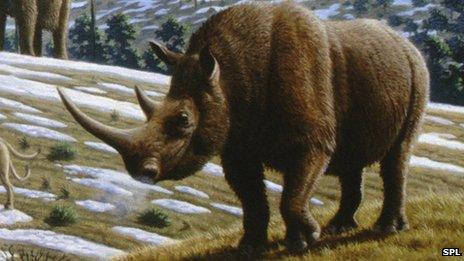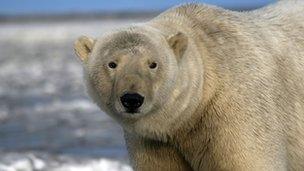Going the way of the woolly rhino?
- Published

Remains of woolly rhinoceros have been found in Scotland
Conservationists are warning that the Scottish wildcat is on the brink of extinction. If the grim prediction becomes reality, the cat will join a list of former wild mammals that once roamed Scotland.
Numbers of pure Scottish wildcats may have fallen as low as 35 leaving the animals at risk of becoming extinct within months, according to the Scottish Wildlife Association.
Disease and inter-breeding with domestic and feral cats are among the main threats to numbers of pure-bred wildcats.
If the species is wiped out, it will join a catalogue of creatures that were once native to Scotland.
Among the most unusual must be the woolly rhinoceros of Bishopbriggs.
The remains are thought to date to about 25,000BC. Scientists believe that the animals lived in the region when it was ice-free, external and before what is known as the Last Glacial Maximum, or LGM.
A milk tooth, external from another woolly rhinoceros was found in January 1931 at Cadder Quarry, near Glasgow, before further remains were found the following year.
Evidence of beasts that once roamed Scotland have also been discovered in the Bone Caves at Inchnadamph, external in Sutherland.

The skull of a polar bear was found in the Highlands
They include the skull of a polar bear, possibly washed into the caves 18,000 years ago.
An almost complete skeleton of a male brown bear that may have died 11,000 years ago were recovered by cavers after years of work.
The caves have proved to be a safety deposit box of other ancient bones, including the skull of a Northern Lynx dated at around 1,770 years old and the remains of an Arctic fox and Arctic lemming.
More recent Scottish extinctions have include beavers and wolves.
The demise of Scotland's native beavers began with the rise of Inverness as a key market place in the Middle Ages for the animals' pelts, according campaign group Scottish Beavers Network.
Castoreum, a secretion produced in a gland below a beaver's tail, was also sought after because it was believed to have health benefits.
The tail itself was also served as a substitute for fish.
Scotland's beavers were wiped out during the 17th Century.
With wolves, many historians believe the very last one was dispatched near Findhorn, in Moray, in 1743 amid an outcry that it had killed two children.
- Published13 September 2012